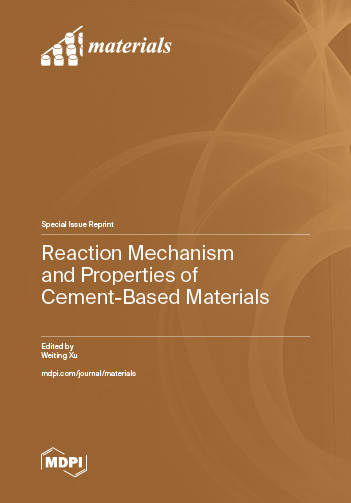Reaction Mechanism and Properties of Cement-Based Materials
A special issue of Materials (ISSN 1996-1944). This special issue belongs to the section "Construction and Building Materials".
Deadline for manuscript submissions: closed (20 July 2024) | Viewed by 19918
Special Issue Editor
Interests: high-performance cement-based materials; shrinkage reduction and toughening mechanism of concrete; prevention and control of concrete cracks; recycling of solid waste; organic-inorganic composite cementitious materials; molecular dynamics simulation
Special Issues, Collections and Topics in MDPI journals
Special Issue Information
Dear Colleagues,
Cement is one of the most important building materials in human history and is used to build various infrastructures due to its high strength, excellent durability, and relatively low cost. The microstructure of cement-based materials is composed of cement paste system, stone, porosity, water content, and other components. Among them, the cement paste system, mainly the hydration product of clinker or reaction precursor, is the most important component of cement-based materials. The microstructure of reaction product, pores, and constituent phase, and the hardening process of cement paste system have crucial influences on the mechanical and physical properties of the resulting materials. The in-depth understanding of the relationship between microstructure and macroscopic properties of cement-based materials helps to design more efficient and stable cementitious materials for construction. Cement-based materials are multi-phase and multi-scale structures, and each component has a different degree of influence on the overall mechanical and physical properties. This Special Issue focuses on, but is not limited to, the mechanism of physicochemical effects on the cracking and toughening properties of cement-based materials in macroscopic scale, such as gelling components, aggregates, admixtures, fibers, water-binder ratio, curing system and environmental effect; the effects of micrometer scale reinforcement materials such as microbeads, whiskers and osmotic crystals on the filling, bridging, bonding and osmotic crystallization in cement-based materials system; the enhancing effect and mechanism of nano-scale reinforcement materials, such as nano-SiO2, nano-CaCO3, graphene, carbon nanotubes, micro-organisms, nano-polymers, etc., on the microstructure of hydration products, growth mode and pore structure of hardened paste; the conjugate toughening effects of cross-scale components such as “carbon fiber + carbon nanotubes” and “fiber + whisker + graphene” on different scales of cement-based materials.
It is my pleasure to invite you to contribute to the Special Issue “Reaction Mechanism and Properties of Cement-Based Materials”. Full papers, communications, discussions, and reviews related to the current research, application and development of strengthening, toughening and durability enhancement components of different scales of cement-based materials, reaction mechanism and properties of various cementitious materials including Portland cement, aluminate cement, sulfate aluminum cement, ferroaluminate cement, phosphate cement are welcomed.
Dr. Weiting Xu
Guest Editor
Manuscript Submission Information
Manuscripts should be submitted online at www.mdpi.com by registering and logging in to this website. Once you are registered, click here to go to the submission form. Manuscripts can be submitted until the deadline. All submissions that pass pre-check are peer-reviewed. Accepted papers will be published continuously in the journal (as soon as accepted) and will be listed together on the special issue website. Research articles, review articles as well as short communications are invited. For planned papers, a title and short abstract (about 100 words) can be sent to the Editorial Office for announcement on this website.
Submitted manuscripts should not have been published previously, nor be under consideration for publication elsewhere (except conference proceedings papers). All manuscripts are thoroughly refereed through a single-blind peer-review process. A guide for authors and other relevant information for submission of manuscripts is available on the Instructions for Authors page. Materials is an international peer-reviewed open access semimonthly journal published by MDPI.
Please visit the Instructions for Authors page before submitting a manuscript. The Article Processing Charge (APC) for publication in this open access journal is 2600 CHF (Swiss Francs). Submitted papers should be well formatted and use good English. Authors may use MDPI's English editing service prior to publication or during author revisions.
Keywords
- cement-based materials
- cement-based composite materials
- kinetics of hydration evolution
- strengthening, toughening, and durability enhancement effect and mechanism
- multi-phase and multi-scale structures of cement-based materials
- macro-properties and micro-structure
- numerical simulation study of cement-based materials
- macro-properties and micro-structure of cement or concrete
- utilization of waste in the production of sustainable cement-based materials
- reaction mechanism of admixtures and their effects on the properties of cement or concrete
- mechanism and properties of 3D printing cement materials
- cement-based functional materials
- Portland cement, aluminate cement, sulfate aluminum cement, ferroaluminate cement, phosphate cement
Benefits of Publishing in a Special Issue
- Ease of navigation: Grouping papers by topic helps scholars navigate broad scope journals more efficiently.
- Greater discoverability: Special Issues support the reach and impact of scientific research. Articles in Special Issues are more discoverable and cited more frequently.
- Expansion of research network: Special Issues facilitate connections among authors, fostering scientific collaborations.
- External promotion: Articles in Special Issues are often promoted through the journal's social media, increasing their visibility.
- Reprint: MDPI Books provides the opportunity to republish successful Special Issues in book format, both online and in print.
Further information on MDPI's Special Issue policies can be found here.







